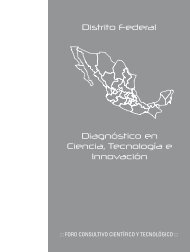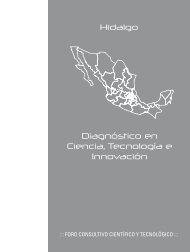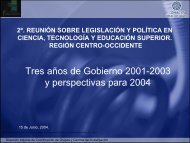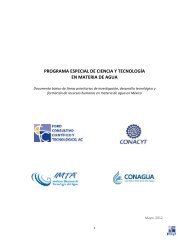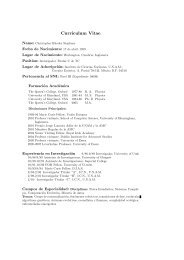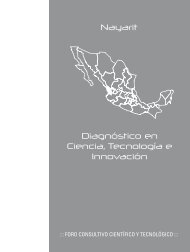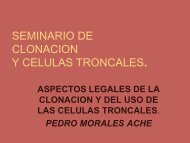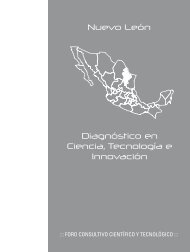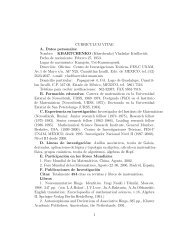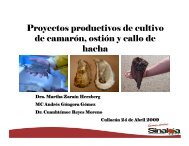- Page 1 and 2:
EL IMPACTO DE LOS FONDOS MIXTOS EN
- Page 3 and 4:
EL IMPACTO DE LOS FONDOS MIXTOS EN
- Page 5 and 6:
ÍNDICE VOLUMEN II EL IMPACTO DE LO
- Page 7 and 8:
EL IMPACTO DE LOS FONDOS MIXTOS EN
- Page 9:
EL IMPACTO DE LOS FONDOS MIXTOS EN
- Page 13 and 14:
Introducción EL IMPACTO DE LOS FON
- Page 15 and 16:
EL IMPACTO DE LOS FONDOS MIXTOS EN
- Page 17 and 18:
EL IMPACTO DE LOS FONDOS MIXTOS EN
- Page 19 and 20:
EL IMPACTO DE LOS FONDOS MIXTOS EN
- Page 21 and 22:
EL IMPACTO DE LOS FONDOS MIXTOS EN
- Page 23:
EL IMPACTO DE LOS FONDOS MIXTOS EN
- Page 26 and 27:
26 EL IMPACTO DE LOS FONDOS MIXTOS
- Page 28 and 29:
28 EL IMPACTO DE LOS FONDOS MIXTOS
- Page 30 and 31:
30 EL IMPACTO DE LOS FONDOS MIXTOS
- Page 32 and 33:
32 EL IMPACTO DE LOS FONDOS MIXTOS
- Page 34 and 35:
34 EL IMPACTO DE LOS FONDOS MIXTOS
- Page 36 and 37:
36 EL IMPACTO DE LOS FONDOS MIXTOS
- Page 38 and 39:
38 EL IMPACTO DE LOS FONDOS MIXTOS
- Page 40 and 41:
40 EL IMPACTO DE LOS FONDOS MIXTOS
- Page 43 and 44:
Introducción EL IMPACTO DE LOS FON
- Page 45 and 46:
EL IMPACTO DE LOS FONDOS MIXTOS EN
- Page 47 and 48: EL IMPACTO DE LOS FONDOS MIXTOS EN
- Page 49 and 50: Tabla 1. Contenido de genes cry de
- Page 51 and 52: Introducción EL IMPACTO DE LOS FON
- Page 53 and 54: Objetivo general EL IMPACTO DE LOS
- Page 55 and 56: EL IMPACTO DE LOS FONDOS MIXTOS EN
- Page 57 and 58: Figura 1. Cartel promocional del li
- Page 59: EL IMPACTO DE LOS FONDOS MIXTOS EN
- Page 62 and 63: 62 EL IMPACTO DE LOS FONDOS MIXTOS
- Page 65 and 66: Introducción EL IMPACTO DE LOS FON
- Page 67 and 68: EL IMPACTO DE LOS FONDOS MIXTOS EN
- Page 69 and 70: EL IMPACTO DE LOS FONDOS MIXTOS EN
- Page 71 and 72: EL IMPACTO DE LOS FONDOS MIXTOS EN
- Page 73 and 74: EL IMPACTO DE LOS FONDOS MIXTOS EN
- Page 75: EL IMPACTO DE LOS FONDOS MIXTOS EN
- Page 78 and 79: 78 EL IMPACTO DE LOS FONDOS MIXTOS
- Page 80 and 81: 80 EL IMPACTO DE LOS FONDOS MIXTOS
- Page 82 and 83: 82 EL IMPACTO DE LOS FONDOS MIXTOS
- Page 84 and 85: 84 EL IMPACTO DE LOS FONDOS MIXTOS
- Page 86 and 87: 86 EL IMPACTO DE LOS FONDOS MIXTOS
- Page 88 and 89: 88 EL IMPACTO DE LOS FONDOS MIXTOS
- Page 90 and 91: 90 EL IMPACTO DE LOS FONDOS MIXTOS
- Page 92 and 93: 92 EL IMPACTO DE LOS FONDOS MIXTOS
- Page 94 and 95: 94 EL IMPACTO DE LOS FONDOS MIXTOS
- Page 96 and 97: 96 EL IMPACTO DE LOS FONDOS MIXTOS
- Page 100 and 101: 100 EL IMPACTO DE LOS FONDOS MIXTOS
- Page 103 and 104: Introducción EL IMPACTO DE LOS FON
- Page 105 and 106: EL IMPACTO DE LOS FONDOS MIXTOS EN
- Page 107 and 108: EL IMPACTO DE LOS FONDOS MIXTOS EN
- Page 109 and 110: 6. Obtención del Biodisel. EL IMPA
- Page 111: Beneficio social EL IMPACTO DE LOS
- Page 115 and 116: Introducción EL IMPACTO DE LOS FON
- Page 117 and 118: EL IMPACTO DE LOS FONDOS MIXTOS EN
- Page 119 and 120: EL IMPACTO DE LOS FONDOS MIXTOS EN
- Page 121 and 122: EL IMPACTO DE LOS FONDOS MIXTOS EN
- Page 123: EL IMPACTO DE LOS FONDOS MIXTOS EN
- Page 126 and 127: 126 EL IMPACTO DE LOS FONDOS MIXTOS
- Page 128 and 129: 128 EL IMPACTO DE LOS FONDOS MIXTOS
- Page 131 and 132: Resumen EL IMPACTO DE LOS FONDOS MI
- Page 133 and 134: EL IMPACTO DE LOS FONDOS MIXTOS EN
- Page 135 and 136: EL IMPACTO DE LOS FONDOS MIXTOS EN
- Page 137 and 138: EL IMPACTO DE LOS FONDOS MIXTOS EN
- Page 139 and 140: EL IMPACTO DE LOS FONDOS MIXTOS EN
- Page 141: EL IMPACTO DE LOS FONDOS MIXTOS EN
- Page 144 and 145: 144 EL IMPACTO DE LOS FONDOS MIXTOS
- Page 146 and 147: 146 EL IMPACTO DE LOS FONDOS MIXTOS
- Page 148 and 149:
148 EL IMPACTO DE LOS FONDOS MIXTOS
- Page 150 and 151:
150 EL IMPACTO DE LOS FONDOS MIXTOS
- Page 152 and 153:
152 EL IMPACTO DE LOS FONDOS MIXTOS
- Page 154 and 155:
154 EL IMPACTO DE LOS FONDOS MIXTOS
- Page 156 and 157:
156 EL IMPACTO DE LOS FONDOS MIXTOS
- Page 158 and 159:
158 EL IMPACTO DE LOS FONDOS MIXTOS
- Page 161 and 162:
Resumen EL IMPACTO DE LOS FONDOS MI
- Page 163 and 164:
EL IMPACTO DE LOS FONDOS MIXTOS EN
- Page 165 and 166:
EL IMPACTO DE LOS FONDOS MIXTOS EN
- Page 167 and 168:
EL IMPACTO DE LOS FONDOS MIXTOS EN
- Page 169 and 170:
Polimorfismos y expresión del gen
- Page 171 and 172:
Participaciones en congresos EL IMP
- Page 173 and 174:
EL IMPACTO DE LOS FONDOS MIXTOS EN
- Page 175:
EL IMPACTO DE LOS FONDOS MIXTOS EN
- Page 178 and 179:
178 EL IMPACTO DE LOS FONDOS MIXTOS
- Page 180 and 181:
180 EL IMPACTO DE LOS FONDOS MIXTOS
- Page 182 and 183:
182 EL IMPACTO DE LOS FONDOS MIXTOS
- Page 185:
EL IMPACTO DE LOS FONDOS MIXTOS EN
- Page 188 and 189:
188 EL IMPACTO DE LOS FONDOS MIXTOS
- Page 190 and 191:
190 EL IMPACTO DE LOS FONDOS MIXTOS
- Page 192 and 193:
192 EL IMPACTO DE LOS FONDOS MIXTOS
- Page 194 and 195:
194 EL IMPACTO DE LOS FONDOS MIXTOS
- Page 196 and 197:
196 EL IMPACTO DE LOS FONDOS MIXTOS
- Page 198 and 199:
198 EL IMPACTO DE LOS FONDOS MIXTOS
- Page 200 and 201:
200 EL IMPACTO DE LOS FONDOS MIXTOS
- Page 202 and 203:
202 EL IMPACTO DE LOS FONDOS MIXTOS
- Page 204 and 205:
204 EL IMPACTO DE LOS FONDOS MIXTOS
- Page 206 and 207:
206 EL IMPACTO DE LOS FONDOS MIXTOS
- Page 208 and 209:
208 EL IMPACTO DE LOS FONDOS MIXTOS
- Page 210 and 211:
210 EL IMPACTO DE LOS FONDOS MIXTOS
- Page 212 and 213:
212 EL IMPACTO DE LOS FONDOS MIXTOS
- Page 214 and 215:
214 EL IMPACTO DE LOS FONDOS MIXTOS
- Page 216 and 217:
216 EL IMPACTO DE LOS FONDOS MIXTOS
- Page 218 and 219:
218 EL IMPACTO DE LOS FONDOS MIXTOS
- Page 220 and 221:
220 EL IMPACTO DE LOS FONDOS MIXTOS
- Page 223:
EL IMPACTO DE LOS FONDOS MIXTOS EN
- Page 226 and 227:
226 EL IMPACTO DE LOS FONDOS MIXTOS
- Page 228 and 229:
228 EL IMPACTO DE LOS FONDOS MIXTOS
- Page 230 and 231:
230 EL IMPACTO DE LOS FONDOS MIXTOS
- Page 232 and 233:
232 EL IMPACTO DE LOS FONDOS MIXTOS
- Page 234 and 235:
234 EL IMPACTO DE LOS FONDOS MIXTOS
- Page 237 and 238:
Introducción EL IMPACTO DE LOS FON
- Page 239 and 240:
EL IMPACTO DE LOS FONDOS MIXTOS EN
- Page 241 and 242:
EL IMPACTO DE LOS FONDOS MIXTOS EN
- Page 243 and 244:
EL IMPACTO DE LOS FONDOS MIXTOS EN
- Page 245:
EL IMPACTO DE LOS FONDOS MIXTOS EN
- Page 248 and 249:
248 EL IMPACTO DE LOS FONDOS MIXTOS
- Page 250 and 251:
250 EL IMPACTO DE LOS FONDOS MIXTOS
- Page 252 and 253:
252 EL IMPACTO DE LOS FONDOS MIXTOS
- Page 254 and 255:
254 EL IMPACTO DE LOS FONDOS MIXTOS
- Page 257 and 258:
Introducción EL IMPACTO DE LOS FON
- Page 259 and 260:
EL IMPACTO DE LOS FONDOS MIXTOS EN
- Page 261 and 262:
EL IMPACTO DE LOS FONDOS MIXTOS EN
- Page 263 and 264:
EL IMPACTO DE LOS FONDOS MIXTOS EN
- Page 265:
EL IMPACTO DE LOS FONDOS MIXTOS EN
- Page 268 and 269:
268 EL IMPACTO DE LOS FONDOS MIXTOS
- Page 270 and 271:
270 EL IMPACTO DE LOS FONDOS MIXTOS
- Page 272 and 273:
272 EL IMPACTO DE LOS FONDOS MIXTOS
- Page 274 and 275:
274 EL IMPACTO DE LOS FONDOS MIXTOS
- Page 276 and 277:
276 EL IMPACTO DE LOS FONDOS MIXTOS
- Page 278 and 279:
278 EL IMPACTO DE LOS FONDOS MIXTOS
- Page 280 and 281:
280 EL IMPACTO DE LOS FONDOS MIXTOS
- Page 282 and 283:
282 EL IMPACTO DE LOS FONDOS MIXTOS
- Page 284 and 285:
284 EL IMPACTO DE LOS FONDOS MIXTOS
- Page 286 and 287:
286 EL IMPACTO DE LOS FONDOS MIXTOS
- Page 288 and 289:
288 EL IMPACTO DE LOS FONDOS MIXTOS
- Page 290 and 291:
290 EL IMPACTO DE LOS FONDOS MIXTOS
- Page 293:
EL IMPACTO DE LOS FONDOS MIXTOS EN
- Page 296 and 297:
296 EL IMPACTO DE LOS FONDOS MIXTOS
- Page 298 and 299:
298 EL IMPACTO DE LOS FONDOS MIXTOS
- Page 300 and 301:
300 EL IMPACTO DE LOS FONDOS MIXTOS
- Page 302 and 303:
302 EL IMPACTO DE LOS FONDOS MIXTOS
- Page 304 and 305:
304 EL IMPACTO DE LOS FONDOS MIXTOS
- Page 306 and 307:
306 EL IMPACTO DE LOS FONDOS MIXTOS
- Page 308 and 309:
308 EL IMPACTO DE LOS FONDOS MIXTOS
- Page 310 and 311:
310 EL IMPACTO DE LOS FONDOS MIXTOS
- Page 313 and 314:
Introducción EL IMPACTO DE LOS FON
- Page 315 and 316:
Objetivo general EL IMPACTO DE LOS
- Page 317 and 318:
EL IMPACTO DE LOS FONDOS MIXTOS EN
- Page 319 and 320:
EL IMPACTO DE LOS FONDOS MIXTOS EN
- Page 321 and 322:
EL IMPACTO DE LOS FONDOS MIXTOS EN
- Page 323:
EL IMPACTO DE LOS FONDOS MIXTOS EN
- Page 326 and 327:
326 EL IMPACTO DE LOS FONDOS MIXTOS
- Page 328 and 329:
328 EL IMPACTO DE LOS FONDOS MIXTOS
- Page 330 and 331:
330 EL IMPACTO DE LOS FONDOS MIXTOS
- Page 332 and 333:
332 EL IMPACTO DE LOS FONDOS MIXTOS
- Page 335:
EL IMPACTO DE LOS FONDOS MIXTOS EN
- Page 338 and 339:
338 EL IMPACTO DE LOS FONDOS MIXTOS
- Page 340 and 341:
340 EL IMPACTO DE LOS FONDOS MIXTOS
- Page 342 and 343:
342 EL IMPACTO DE LOS FONDOS MIXTOS
- Page 344 and 345:
344 EL IMPACTO DE LOS FONDOS MIXTOS
- Page 346 and 347:
346 EL IMPACTO DE LOS FONDOS MIXTOS
- Page 348 and 349:
348 EL IMPACTO DE LOS FONDOS MIXTOS
- Page 351 and 352:
Introducción EL IMPACTO DE LOS FON
- Page 353 and 354:
EL IMPACTO DE LOS FONDOS MIXTOS EN
- Page 355 and 356:
EL IMPACTO DE LOS FONDOS MIXTOS EN
- Page 357 and 358:
EL IMPACTO DE LOS FONDOS MIXTOS EN
- Page 359 and 360:
EL IMPACTO DE LOS FONDOS MIXTOS EN
- Page 361:
EL IMPACTO DE LOS FONDOS MIXTOS EN
- Page 364 and 365:
364 EL IMPACTO DE LOS FONDOS MIXTOS
- Page 366 and 367:
366 EL IMPACTO DE LOS FONDOS MIXTOS
- Page 368 and 369:
368 EL IMPACTO DE LOS FONDOS MIXTOS
- Page 370 and 371:
370 EL IMPACTO DE LOS FONDOS MIXTOS
- Page 372 and 373:
372 EL IMPACTO DE LOS FONDOS MIXTOS
- Page 374 and 375:
374 EL IMPACTO DE LOS FONDOS MIXTOS
- Page 376 and 377:
376 EL IMPACTO DE LOS FONDOS MIXTOS
- Page 378 and 379:
378 EL IMPACTO DE LOS FONDOS MIXTOS
- Page 380 and 381:
380 EL IMPACTO DE LOS FONDOS MIXTOS
- Page 382 and 383:
382 EL IMPACTO DE LOS FONDOS MIXTOS
- Page 385:
EL IMPACTO DE LOS FONDOS MIXTOS EN
- Page 388 and 389:
388 EL IMPACTO DE LOS FONDOS MIXTOS
- Page 390:
390 EL IMPACTO DE LOS FONDOS MIXTOS



